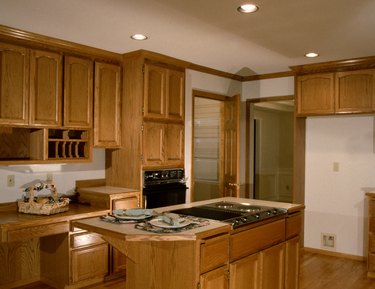
Kitchen cabinets are typically manufactured to withstand all the wear and tear of a long life of normal service. Initially choosing the right cabinets for the job is vital, and as Lowe's own Kitchen Cabinet Buying Guide observes, "The choices and decisions may seem endless." If cabinets later transpire to be unsuitable for a specific duty, they can be reinforced.
Why Reinforce Cabinets
Video of the Day
Cabinetry is the core structure of most kitchens, and both its static and its moving parts are subject to considerable stress over years of service. It may be that the static parts -- the sides and uprights that carry the weight of the countertops -- prove too weak, perhaps for an extremely heavy appliance or a large, fully laden wine rack. New countertops can be very weighty in and of themselves if they are made of a dense material, such as granite. The moving parts -- hinges and door catches, for example -- may wear out before the cabinetry itself, or the fastener points can become loose and need reinforcement.
Video of the Day
Methods of Reinforcing
Fu-Tung Cheng, co-author of "Concrete Countertops: Design, Forms and Finishes for the New Kitchen and Bath," has commented that 3/4-inch plywood is his preferred material for cabinets that will support heavy retrofitted countertops. It is seldom practical to replace the sides and backs of cabinets that are already fitted in place, so internal framing -- called a carcass -- can be used as a reinforcing structure. A thick plywood sub-top fitted over the cabinets before new countertops are laid can help distribute weight evenly over a large area. Alternately, angled iron hardware can be used inside cabinets for a discrete but sturdy reinforcing job.
If the cabinets are supported on flimsy legs, this foundation can be a strategic weak point. Replace the legs entirely with heavy-duty aftermarket parts or with solid blocks of pressure-treated wood if future adjustment will not be necessary.
Cabinet backs are typically insubstantial. If an appliance that creates a great deal of motion -- such as a commercial-use food processor -- is to be used on a countertop and if fasteners driven through the cabinet backs are used to anchor the cabinets to the wall, the backs should be reinforced.
Things to Remember
When reinforcing more than one cabinet, mark all the pieces you remove so they can go back in the correct locations. It is particularly important to number cabinets and doors before dismantling, so that fastener holes and catches will all line up again when the doors are replaced. Drawers often "bed in" to their runners and can jam or feel too loose if repositioned.
Dressing Up the Kitchen
When reinforcing the cabinets, consider dressing them up with new hardware or doors and drawer-fronts rather than replacing the existing ones. If it has been necessary to remove the doors, hinges and catches to gain access to the points that needed reinforcing, half the job of fitting new flourishes has already been done.